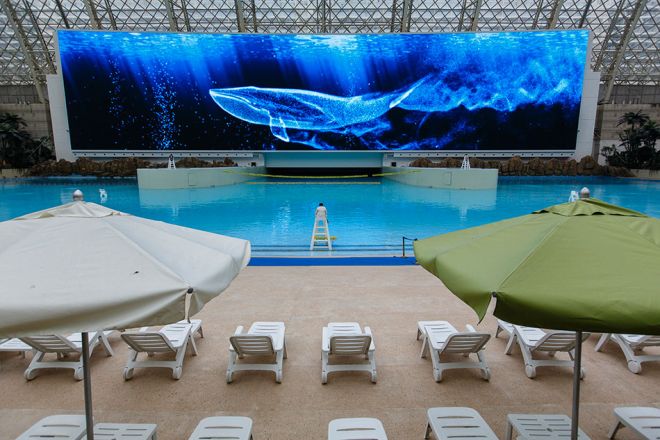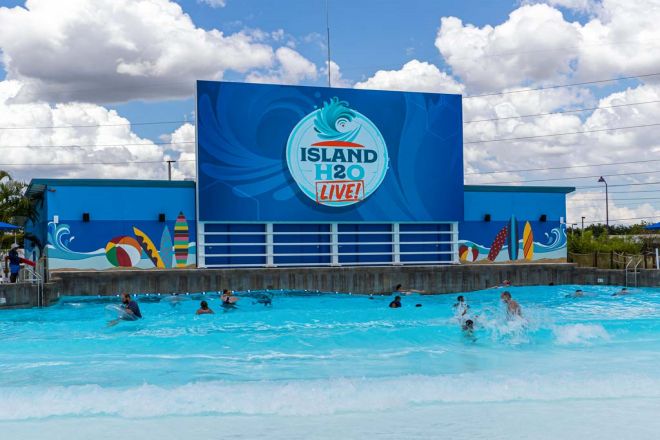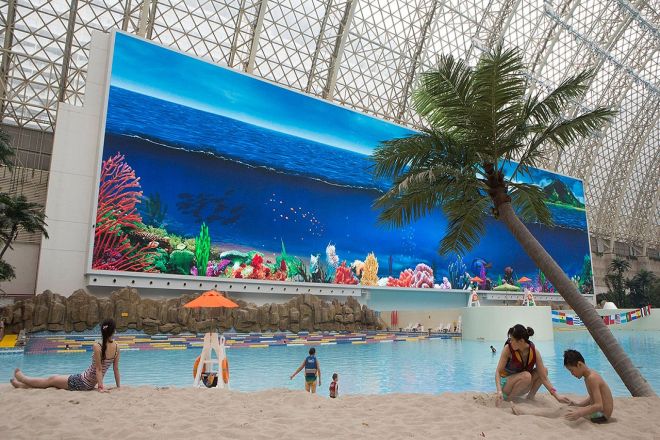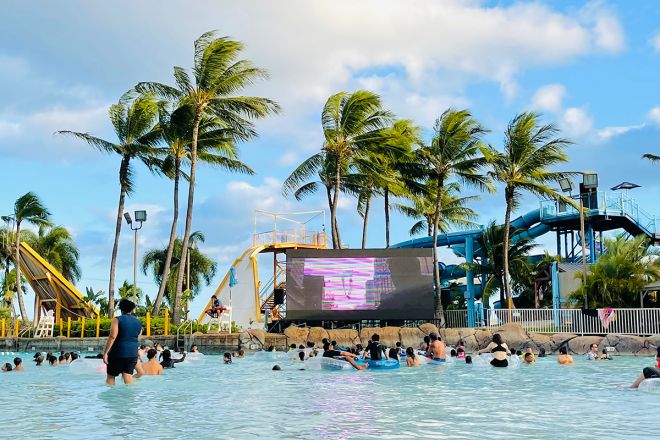介绍

随着水上乐园的普及,如何提高游客的体验度成为水上乐园经营者关注的一个重点。其中, LED显示屏 作为信息展示、活动宣传的重要工具,在水上乐园的应用越来越广泛。
但由于水上乐园环境特殊,湿度大,阳光强烈,对LED显示屏的性能提出了更高的要求。
1.防水、耐候性要求

1).防水性能
- 显示器外壳:
显示屏外壳必须达到较高的防水等级(如IP67以上),以保证在水上乐园潮湿或浸水的环境下正常工作。外壳设计应严密无缝,防止湿气渗透。
- 内部电路和元件:
显示屏内部的电路和元器件必须做好防水处理,包括防水涂层、密封处理、防水包装等,防止湿气侵入造成短路或损坏。同时还要保证所有连接件、接口均具有良好的防水性能。
- 安装位置:
显示器的安装位置应谨慎选择,远离可能的水源,例如水池、水滑梯等。这可以减少意外溅水或水流对显示器的影响。
2). 耐候性
- 耐恶劣气候:
由于水上乐园经常面临阳光直射、高温、高湿等恶劣气候,因此显示屏必须具有出色的耐候性。这包括能够抵抗紫外线、保持鲜艳色彩、保持清晰度并在高湿度下正常工作。
- 耐腐蚀材料:
显示屏材质应具有耐腐蚀性,能够抵抗水上乐园常用的化学清洁剂或盐等物质的侵蚀。这有助于确保显示屏在长期使用过程中不会受到化学腐蚀的影响。
- 耐候性测试:
在制造过程中,显示器应经过严格的耐候性测试,以验证其在各种恶劣气候条件下的性能和稳定性。这些测试可以模拟长期阳光直射、高温、高湿等环境,以确保显示器在实际使用中能够长时间可靠运行。
2.显示效果及亮度要求
1). 显示效果
- 高清晰度、高对比度:
水上乐园的LED显示屏应具有高清晰度和高对比度,以确保游客在远处和阳光直射下都能清晰地看到显示内容。高分辨率的显示屏可以提供更细腻逼真的图像,而高对比度则确保在强光下显示内容仍然清晰可见。
- 色彩鲜艳、饱和度高:
为了吸引游客的注意力,显示屏需要呈现色彩鲜艳、饱和度高的图像,鲜艳的色彩可以激发游客的兴趣,增强游客的游玩体验。
- 支持多种格式:
显示屏应支持多种格式的显示内容,包括图片、视频、文字等,以便根据不同的宣传需求灵活调整显示内容,为游客提供更加丰富多样的信息展示。
2). 亮度
- 足够高的亮度:
水上乐园LED显示屏需要有足够的亮度来应对阳光直射下的高亮环境,高亮度的显示屏可以保证在强光照射下显示内容依然清晰可见,为游客提供更好的观看体验。
- 自动亮度调节功能:
为了节省能源和适应不同的环境光,显示屏应该具有自动亮度调节功能。该功能可以根据环境光的变化,自动调节显示屏的亮度,保证在光线暗的时候不会太刺眼,同时在光线亮的时候又能保持足够的亮度。
- 夜间模式:
考虑到夜间使用的需求,显示屏应具备夜间模式。夜间模式下,显示屏可以降低亮度,避免给游客带来不适。同时,夜间模式还可以根据需要调整显示内容的色彩和亮度,提供更舒适的观看体验。
3.稳定性和可靠性要求

1). 稳定性
- 电源供应:
显示屏必须配备稳定的供电系统,确保在长期运行过程中不会因电源波动或中断而出现故障,包括使用高品质的供电设备、备用电源、智能电源管理系统等。
- 冷却系统:
高效的散热系统是保证显示器稳定运行的关键,显示器应配备合适的散热设备,如风扇、散热器等,保证内部元器件在高温环境下不会过热,从而保证其性能和寿命。
- 电磁干扰与信号衰减:
显示屏内部电路设计应合理,避免电磁干扰和信号衰减,采用优质的电器元件、合理的布线、有效的屏蔽措施,可以保证信号传输的稳定性和准确性。
- 远程监控与故障诊断:
为了能够及时发现和处理问题,显示屏应支持远程监控和故障诊断功能。通过远程监控,管理员可以实时了解显示屏的运行状态;通过故障诊断功能,可以快速定位故障并进行修复,减少停机时间。
2). 可靠性
- 使用寿命及故障率:
显示屏应具有较长的使用寿命和较低的故障率,通过选用优质的材料、优化的设计、严格的制造工艺,可以保证显示屏在长期使用中保持稳定的性能和可靠性。
- 模块化设计:
为了方便维护和更换故障模块,显示屏应采用模块化设计,将显示屏分成多个独立的模块,每个模块都有独立的功能和接口,这样可以方便地进行模块的更换和升级,提高维护效率。
- 防雷、防静电措施:
水上乐园所处环境可能存在雷电、静电等潜在威胁,因此显示屏应有相应的防护措施。通过安装防雷设备、使用防静电材料,可以保证显示屏在恶劣环境下的安全运行。
4.安装和维护要求
1). 安装
- 视角和距离:
显示屏的安装位置要充分考虑游客的观看角度和距离,保证大多数游客能得到最佳的观看效果。这就需要对水上乐园的布局和游客的人流路径进行详细的分析,确定最佳的安装位置。
- 坚固的支架或墙壁:
显示屏应安装在坚固的支架或者墙面,以保证其稳定性和安全性。特别是在强风或者水冲击的情况下,安装结构必须能够抵抗这些外力的影响,防止显示屏脱落或者受损。
- 防水及电气安全:
在安装过程中,要特别注意防水和电气安全,显示屏外壳及内部电路必须符合防水要求,防止水侵入造成设备损坏或安全事故。
同时,所有电气连接及接线均须符合安全标准,避免漏电、短路等电气安全隐患。
2). 维护
- 定期清洁和保养:
为了保持显示屏整洁、显示效果良好,应定期对显示屏进行清洁和保养,包括清除显示屏表面的灰尘、污渍等杂物,检查、修复损坏的像素或模块,调整显示屏的亮度、对比度等参数。
- 系统检查:
定期检查电源、散热等显示屏系统,确保其正常运行。
包括检查电源是否稳定,散热设备是否正常工作,连接线是否有松动或者损坏等,如果发现问题要及时处理,避免影响显示屏的正常使用。
- 故障处理:
当显示屏出现故障时,应及时进行维修,或更换故障模块。这就要求维护人员具备专业的技能和知识,能够快速准确地诊断问题并采取相应的处理措施。
同时应建立完整的故障处理流程,确保故障得到及时有效的处理,避免影响游客的体验。
5.安全要求

1). 电气安全
- 符合标准:
显示屏必须严格遵守相关的电气安全标准,确保电源和设备运行的绝对安全。这包括使用标准的电气元件、电缆和连接器,以及正确的安装和接线方法。
- 保护功能:
显示屏应具备过流、过压、过热等保护功能,防止因电气异常而引起设备损坏或火灾等严重安全事故。这些保护功能应能自动检测异常情况并采取相应措施进行保护。
2). 人类安全
- 合理设计:
显示屏的边角及突出部分应合理设计,避免出现锐利的边缘或突出部分,降低游客意外受伤的风险。另外,显示屏的安装位置还应考虑到游客的活动范围,避免与游客发生碰撞。
- 参数控制:
显示屏的亮度、对比度等参数应控制在合理的范围内,避免对游客的视力产生不利影响。过高的亮度或对比度可能会使游客感到不适或疲劳,甚至可能对视力造成长期损害。因此,应根据实际环境和需求合理设置这些参数。
结论
水上乐园安装的LED显示屏需要满足防水耐候性、显示效果及亮度、稳定性可靠性、安装维护、安全性等多方面的要求。
只有满足这些要求,才能保证LED显示屏在水上乐园环境中稳定运行,为游客提供清晰、生动的信息显示,提升游客的游玩体验。
最后,如果你想了解更多关于LED显示屏的信息, 请与我们联系。
